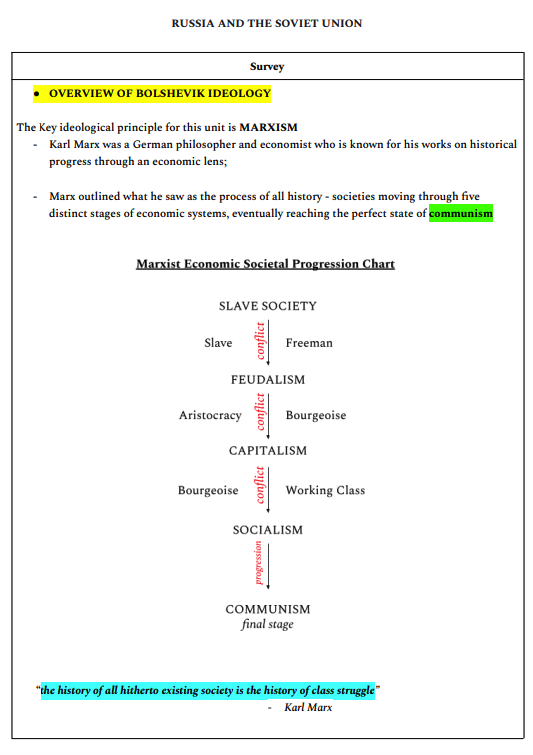Russia and Soviet Union Notes
Summary:
The summary of “Russia and the Soviet Union” covers key aspects of Bolshevik ideology, the Base-Superstructure model, Bolshevik party origins, and the early Soviet government.
The foundation of Bolshevik ideology is based on Marxism, with the ultimate goal of achieving communism through the proletariat’s victory over the bourgeoisie. In Marxist theory, societies progress through different economic systems, eventually reaching the state of communism.
The Base-Superstructure model explains how the economic system (base) shapes the other aspects of society (superstructure). Under Stalinism, for example, art, education, and science were influenced to align with socialist ideals.
Vladimir Lenin, the founder of the Russian Communist Party (the Bolsheviks), led the Bolshevik Revolution and became the first head of the USSR. The Bolsheviks believed in speeding up the process towards communism through continuous revolutions, known as “permanent revolution.”
1917 during the October Coup, the Bolsheviks seized power and established the Sovnarkom, introducing various decrees to empower workers and peasants and assert their control. The Constituent Assembly was abolished, censorship was enforced, and the secret police force, Cheka, was established to suppress opposition.
Excerpt:
Russia and Soviet Union Notes
RUSSIA AND THE SOVIET UNION
Survey
● OVERVIEW OF BOLSHEVIK IDEOLOGY
The Key ideological principle for this unit is MARXISM
– Karl Marx was a German philosopher and economist who is known for his works on historical progress through an economic lens;
– Marx outlined what he saw as the process of all history – societies moving through five distinct stages of economic systems, eventually reaching the perfect state of communism.
….
NOTABLE ECONOMIC SYSTEMS:
Capitalism:
– People and companies make most of the decisions and own most of the property.
– Goods are usually made by individuals who work for companies that produce the goods.
– The companies then sell what is made by the individuals and make a profit.
– The means of production are largely or entirely privately owned (by individuals not making the goods or companies) and operated for profit).
– The word comes from “capital”, meaning something of value. This can be money (“financial capital”) or other goods that can be traded.


Reviews